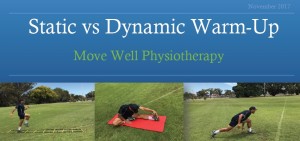WHAT IS A WARM-UP?
A warm-up generally consists of a GRADUAL increase in intensity in physical activity, joint mobility exercise and stretching followed by the activity. The warm-up should be a combination of light rhythmic exercise and stretches which begins to raise the heart rate and muscular temperature of an athlete. An adequate warm-up will help reduce the risk of injury.

BENEFITS OF WARM-UP
• Faster, more forceful muscular contractions
• Improved muscle control
• Improved joint ROM
• Leads to efficient calorie burning by increasing your core body temperature
• Psychologically prepare you for higher exercise intensities by gradually preparing the body and mind
WHAT TYPE OF STRETCHING SHOULD YOU PERFORM?
Static stretching as part of warm-up prior to exercise has been shown detrimental to dynamometer-measured muscle strength and performance in running and jumping.
The loss of strength resulting from acute static stretching has been termed “stretch induced strength loss.” Therefore, stretching programs may need to be individualized.
In general, it appears that static stretching is most beneficial for athletes requiring flexibility for their sports (e.g., gymnastic, dance, etc.).
Dynamic stretching may be better suited for athletes requiring running or jumping performance during their sport such as hockey players or sprinters. (ACSM Introduction To Exercise Science, American College of Sports Medicine September 2013).
If you would like further information please contact Rivervale Physiotherapy on (08) 9361 4041 or download this PDF here or via image below (2 MB) which has examples and illustrations of our stretching and warm up recommendations.



